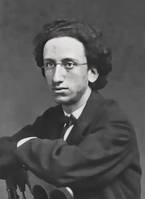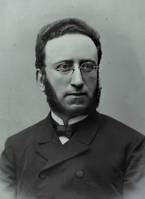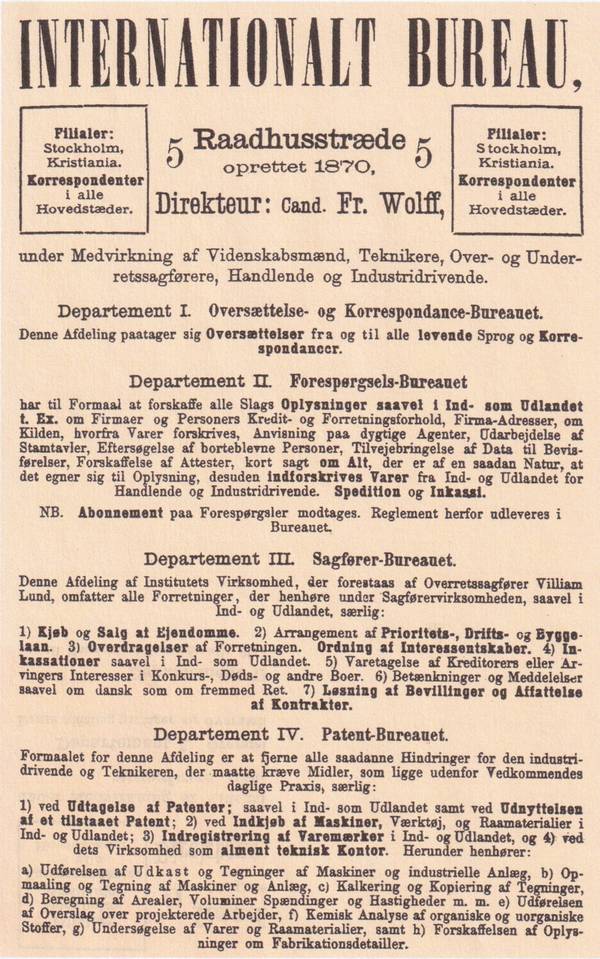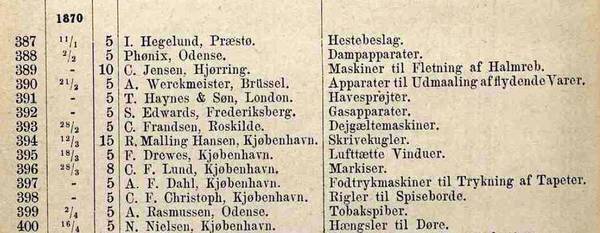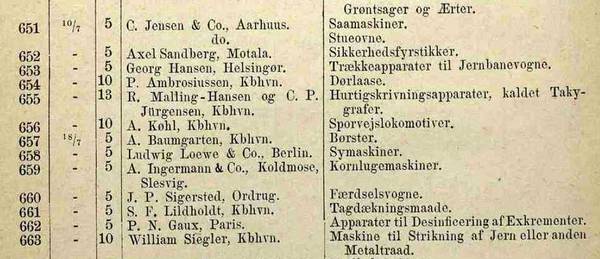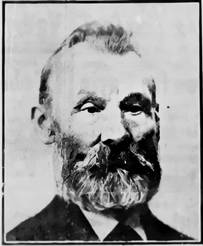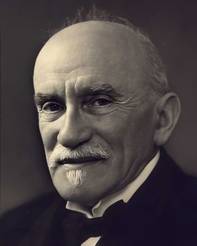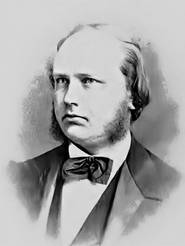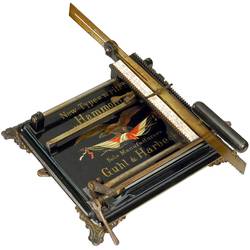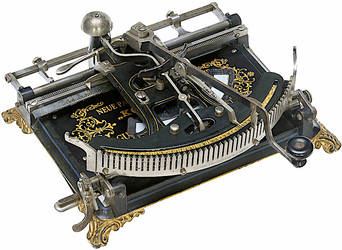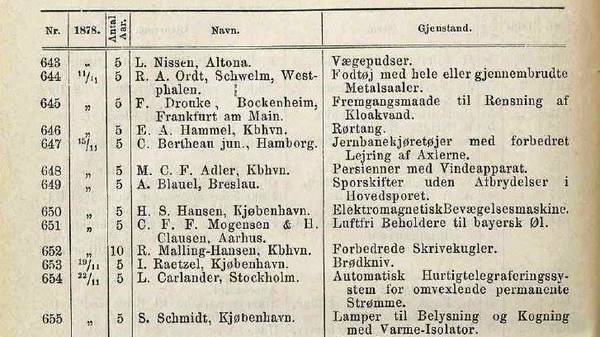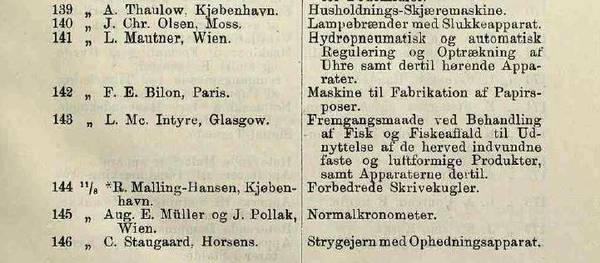Danish Patents 1864 – 1884.
Research and text by Jørgen Malling Christensen.
--------
Thanks to the ongoing process of digitalization of old documents and books, we can access an increasing number of valuable and rare written sources. One such source of considerable importance to our Society are the three volumes published by Frederik Wolff (1842-1896), in Copenhagen:
1) ‘Kronologisk Fortegnelse over Eneretsbevillinger udtagne i Danmark 1864-1874’ (’Chronological Register of Danish Patents 1864-1874’)
2) ’Patenter (Eneretsbevillinger)udtagne i Danmark fra 1875-79’ (’Danish Patents 1875-79’)
3) ’Patenter (Eneretsbevillinger) udtagne i Danmark fra 1880-84’ (’Danish Patents 1880-84’).
Each volume has three parts: A) A chronological list of all patents approved, detailing the date of the license, the time period it is valid, the name of the person holding the patent, and the type of item or process to which it refers. B) The second part has an alphabetic register of names of the patency holders, allowing us to quickly locate a person of our interest. C) The third part of the volume is a subject index.
The author and publisher of these extremely useful volumes was Frederik Harald Sophus Wolff[1], 1842-1896. He signed as Cand. Fr. Wolff, and he ran an agency from 1870 until his early demise in 1896 – ‘Internationalt Bureau’ based in Raadhusstræde 5, a central location of Copenhagen. This agency had a rather diversified agenda with four departments or branches:
1) Translations to and from ‘all living languages’;
2) General information services about goods, services, credit rating, collection of debt, shipping services etc;
3) Legal services: Real estate sales, loan arrangements, transfer of ownership of estates and businesses, contract wording and legalization of documents;
4) Patent agency.
In this part of the article, we shall list the patents of relevance for our research, patents related to writing balls and typewriters.
Patents 1864-1874
# page 10: Patent no 394, given on March 12, 1870, for 15 years to R. Malling Hansen, Copenhagen for “Skrivekugler” (writing balls).
JMC: This was Malling-Hansen’s first Patent, awarded for his very first writing ball model, the so-called ‘box model’, which used batteries. The first public display of this model was in September 1870, and it received a lot of attention.
# page 13: Patent no 521, given on August 27, 1871, for 10 years to Jacob Arend Peters, Copenhagen, for “Skrivemaskiner” (typewriters).
# page 14: Patent no 586, given on January 17, 1872 for 10 years to Jacob Arend Peters, Copenhagen, for “Skrivemaskiner” (typewriters).
JMC: Our mission is, of course, not to document J.A.Peters and his attempt to produce typewriters; however, the name of Peters became historically linked to that of Malling-Hansen because of the ‘Controversy’ in 1924-1925, when Professor Hannover of the Danish Technical University and others tried to argue that Peters was the real inventor of a forerunner to the writing ball.
The claims were soundly rebuffed by two of Malling-Hansen’s daughters, notably Johanne Agerskov and Engelke Wiberg. In March 1925 Johanne Agerskov published a very solidly documented account in defense of her father: “Hvem er Skrivekuglens Opfinder?” (‘Who is the Inventor of the Writing Ball?’)and doubtlessly dispelled all misunderstandings about the originality of the Malling-Hansen writing ball.
The truth is, that Peter’s invention - albeit having been awarded two Danish patents – had very little in common with the writing ball; moreover: already the technical assessment of the people who assessed his drawings and prototypes back in the period of 1871-1872 was negative, and he never found any financial or technical backing for his invention.
All of this is abundantly documented in our large chapter: ‘The Controversy of 1924/25’. Of course, Rasmus Malling-Hansen never copied any part or principle of the crude machine Peters invented; the writing ball was, in terms of design and technique, vastly superior, and Malling-Hansen did not learn anything from the Peters machine (quite possibly, he did not know about the existence of its design). The claim that Peters had ‘invented’ or designed his machine back in 1868 has no bearing whatsoever on this issue. It is irrelevant.
# page 16: Patent no 655, given on July 10, 1872 for 13 years to R.Malling-Hansen and C.P.Jürgensen, Copenhagen, for “Hurtigskrivningsapparater, kaldet Takygrafer” (instruments for speed writing, called Tachygraphs)
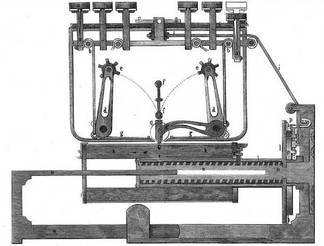
- This is Peter’s typewriter, as it was described in Danish newspapers already in 1868 and later patented and presented in Denmark as well as in Germany in 1872. It should be obvious to everyone that this typewriter has absolutely nothing in common with Malling-Hansen’s writing ball. It is based on a totally different principle, called the barbell principle. In his authoritative work, “Antique Typewriters: From Creed to Qwerty”, Michael Adler states (p. 112): “Peter’s machine used thirty-five slightly curved type plungers located by three parallel horizontal plates to type down on a flat paper table”.
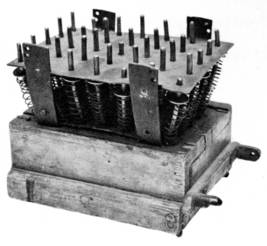
- The confusion arising in 1924 came about when one of Peter’s relatives alerted professor Hannover to the existence of a set of pistons, or plungers, allegedly made by Peters. One has to admit that the plungers, and their arrangement, bears some small resemblance with those of the writing ball, but at the same time the design is clearly very different – being flat, while Malling-Hansen’s plungers and keys form a perfect sphere and are angled all the way, gradually and individually formed, so as to hit the perfect center of the sphere. We shall also add, that this is the only known part of Peter’s typewriter to exist – belonging to the Danich Technical Museum - , whereas Malling-Hansen’s writing ball was, and is, a fully functioning typewriter.”
Patents 1875-79.
# page 20: Patent no 652, given on November 15, 1878 for 10 years to R.Malling-Hansen, Copenhagen for “Forbedrede Skrivekugler” (Improved writing balls)
JMC: I note, with some surprise, that no other patents for typewriters were issued during the period 1875-79.
Patents 1880-84.
# page 5: Patent no 144, given on August 11, 1880 for 10 years to R.Malling-Hansen, Copenhagen, for “Forbedrede Skrivekugler” (Improved writing balls).
JMC: This is a patent, that we have previously assumed to exist, but this is the first time that we find solid documentary proof for it. My conjecture is that this patent refers to the writing ball with the special feature of being able to type both upper-case and lower-case letters. Unfortunately, we have not yet found such a writing ball. Now that we have precise information about the patent, our next research task is to locate the patency application.
SA: As we don't know the patent from 1880 in detail, we can anly make more or less qualified guesses about the content of this patent. My guess is somewhat different than Jørgen's, as I find it more likely that the patent was about the model from 1879, which RMH tells his brother about in a letter from December 1879. The new model was lower and wider than the 1878-modell, and was also lighter. I have held the model with my own hands, and I can confirm that it was a much lighter model then the 1878-specimen.
It was the mechanic August Lyngbye who advertised for the writing ball that could write in both upper and lower case letters, and we know from before that he didn't start producing writing balls until 1885. I therefore find it not very likely that Lyngbye received a patent for a writing ball already in 1880.
But of course, there was also a possibility that the producer behind the 1879-model could make their writing ball with upper and lower case letters. We assume that the mechanics in question was Otzen and Lund.
# page 37: Patent no 1096, given on October 10, 1883 for 5 years to A. Hansen, Hamburg for “Typeskrivemaskine” (Typewriter)
JMC: Searching on the internet and using ‘hansen’ together with ‘typewriter’ I am directed to a German machine by the name of ‘Continental’, produced by Wanderer-Werke, Chemnitz, Germany. However, I am unsure whether this is the machine for which a Danish patent was awarded to Mr A.Hansen of Hamburg, because the first Continental from this company only appeared in 1904.
SA: The typewriter in question was probably Hammonia, from 1882. It was constructed by the inventor Andreas Hansen and manufactured by Guhl & Harbeck, Hamburg. The machine was a socalled index-typewriter, and was not equipped with a keyboard. Some years later they launched a new machine, called Kosmopolit, which came from the same inventor and produser. Both these machines were index-machines without a keyboard.
JMC: Again, it is somewhat surprising that the volume of Danish patents 1880-84 only has the above two patents related to typewriters.
[1] JMC: Fr. Wolff is not listed in the Danish Wikipedia, nor in the ‘Dansk Biografisk Lexikon’ or in ‘Salmonsens Lexikon’. However, I did find him in the Copenhagen census of 1885, where he is registered at Raadhustræde nr 5, first floor as single with no children, 42 years old, belonging to the Jewish community, and the owner of a “Patent-bureau”. In another source – ‘Ejendomsmæglernes Historie’ (The History of Danish Estate Agents), 1997, Edited by Ib Bjørnbak, I found that Fr. Wolff was a son of the Chief Rabbi Abraham Alexander Wolff, 1801-1891, who was chief rabbi in Denmark from May 15, 1829 until his death. He was married to Johanne Goldschmidt, 1806-1876. In the 1850 census, rabbi Wolff and his wife are registered as living at Nørregade 41 with 12 children, born in the period from 1828 to 1846.

